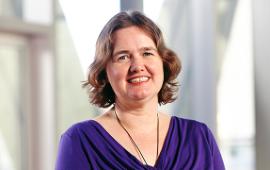Recycling carbon dioxide

In Summary
- Dr Rosalie Hocking has been working to develop devices that could convert carbon dioxide-like molecules into useful things like glucose and fuel
One of the biggest challenges facing the 21st century is global warming and the effects of carbon dioxide on the planet.
Swinburne’s Dr Rosalie Hocking has been looking at ways to mitigate that threat by developing devices capable of taking carbon dioxide-like molecules and converting them into useful things like glucose and fuel – much like the biological process of photosynthesis.
“If we could do this we wouldn’t have to worry about burning fuels and making carbon dioxide because we could recycle the carbon dioxide to make the fuels again,” Dr Hocking says.
Dr Hocking’s particular expertise is in characterising materials. She has developed new ways to look at functional devices including prototype fuel cells, and new devices for harvesting solar energy, using the x-rays produced at the Australian Synchrotron.
“One of the most exciting things is that we are about to get a brand new beamline, giving us access to a key piece of infrastructure and an exciting new tool set in the mid energy X-ray range,” Dr Hocking says.
Dr Hocking says this is key for characterising a wide range of materials from soils to novel batteries and catalysts.
“Many of the cutting edge catalysts for carbon dioxide reduction need this new beamline and its energy range for characterisation, so I am really looking forward to getting a chance to learn more about how those devices work,” she says.
“Our work is in spectroscopy and understanding how things work. What we do is important because it helps us design new materials for clean energy processes." - Dr Rosalie Hocking
Women in STEM Fellow
Dr Hocking has been pursuing her research at Swinburne since mid-2017, as one of the Vice-Chancellor’s Women in STEM Fellows.
“I have always been interested in figuring out how things work,” she says.
“When I started university I wanted to study physics and astronomy. But I did a year-in-industry at the Australian Nuclear Science and Technology Organisation (ANSTO).
“We were developing new methods to separate radioisotopes and I became fascinated with chemistry and how it could readily be applied to a number of problems.”
Dr Hocking says she enjoys placing science into a global context.
“Our work is in spectroscopy and understanding how things work. What we do is important because it helps us design new materials for clean energy processes,” she says.
Dr Hocking presented her research on metal oxides and metal sulphides at the Resources of the Future meeting in Adelaide on 12 February 2018.

